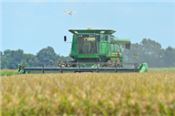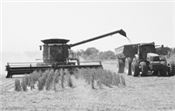|
Louisiana Farmers See Good Yields Despite Tough Conditions In 2017

A combine harvests rice near Crowley, Louisiana. This year’s crop won’t set any records after
excess rainfall stretched into the harvest, making field conditions difficult to cut rice. The quality
of the rice also suffered from the wet conditions. Rice prices did see an uptick because of a
reduction in acreage in the United States. Most of the reduction occurred in Arkansas.
Photo by Bruce Schultz/LSU AgCenter
BATON ROUGE, LA.
An early spring got many row crops in Louisiana off to a fast start. Unfortunately, a wet summer kept many crops from reaching their potential and caused quality issues once farmers began to harvest.
Tropical storms Cindy and Harvey contributed to a reduction in the state’s rice crop and were responsible for reducing the quality of some soybeans in the state.
Despite unfavorable weather during the latter part of the growing season, several crops had above- average yields.
Preliminary corn yield figures had the statewide average at 183 bushels per acre, which is near the state record of 186 bushels per acre.
The statewide average this year for soybeans increased by five bushels to 54 bushels per acre compared with 2016. However, the quality of this year’s crop was affected by the weather, and producers suffered a price reduction.
Cotton acreage increased by 50 percent from last year, but it also was a victim of the weather and saw yield and quality projections decrease from earlier in the season. Yields are expected to be from 850 to 900 pounds per acre this year, which is 50 to 100 pounds per acre less than last year.
With a little less than a month left in the sugarcane grinding season, LSU AgCenter sugarcane specialist Kenneth Gravois is expecting Louisiana to produce a record amount of sugar per acre.
“This year we have good sugar recovery,” Gravois said. “In addition, we have good tons of cane per acre. So we have sugar and tonnage, and that’s a great combination,” he said.
The record for sugar per acre was set in 2012 at 8,415 pounds per acre.
The timing of Tropical Storm Cindy had a major effect on the state’s rice crop. Rice was at the pollination stage, and the windy and overcast conditions following the storm caused grains to go unfilled. Tropical Storm Harvey also damaged rice in southwest Louisiana, causing some acres to go unharvested.
AgCenter economist Kurt Guidry said that producers came away disappointed at the end because crops were in good to excellent condition before the rains.
“I think we had significant crops out there for most of our commodities,” Guidry said. “And then the heavy rains, the late-season rains, really kind of limited our ability to reach those potential yields that were out there.”
Lower or stagnant commodity prices also are pressuring farmers. To make up for lower prices, it is essential to have good yields.
“Our producers can handle lower commodity prices as long as we’re getting some of our above-average or near-record yields,” Guidry said. “So weather is obviously a big component in terms of them being able to do that.”
According to Guidry, U.S. production for many commodities has been good, leading to surplus and pressuring prices downward.
Rice prices did increase this year, and Guidry indicated the rise was based on a national reduction in production acreage. Arkansas, the nation’s largest rice producer, saw a significant reduction in acres this year. Forecasts for next year see an increase in Arkansas acreage, which could lower prices.
Guidry said a new farm bill is on the horizon, and producers will have to keep an eye on changes that might occur.
“There’s always a chance we can see some pretty significant changes to these farm bills,” he said. “That’s something we’re going to have to monitor and make sure the levels of support, the safety net that is in the farm bill, really does provide some support and comfort for our agriculture producers.” ∆
 Anthony Plattsmier harvests soybeans in St. Landry Parish. Soybean yields were about
Anthony Plattsmier harvests soybeans in St. Landry Parish. Soybean yields were about
five bushels per acre higher than last year, but the beans suffered damage from excessive rainfall.
Photo by Bruce Schultz/LSU AgCenter
|
|